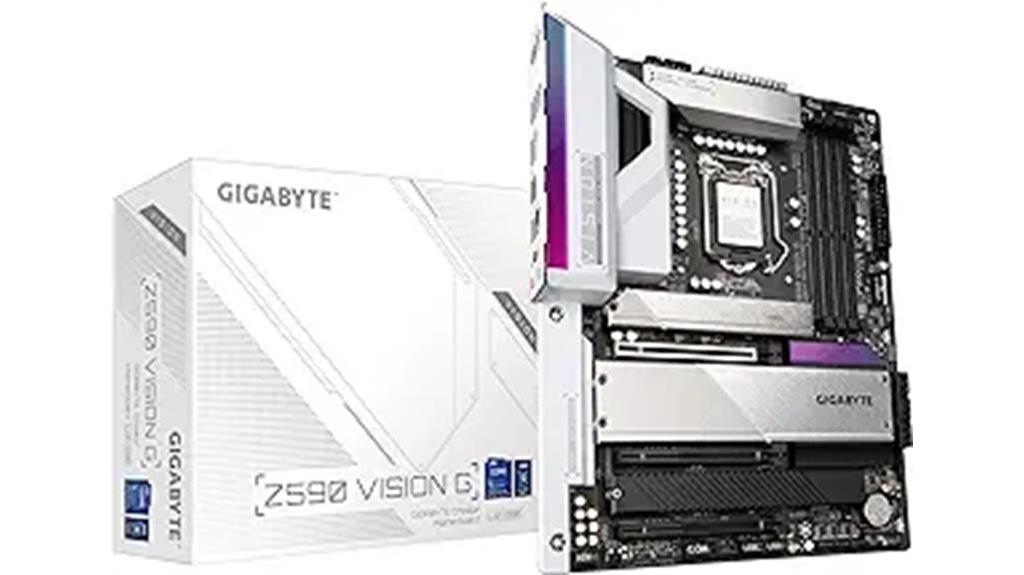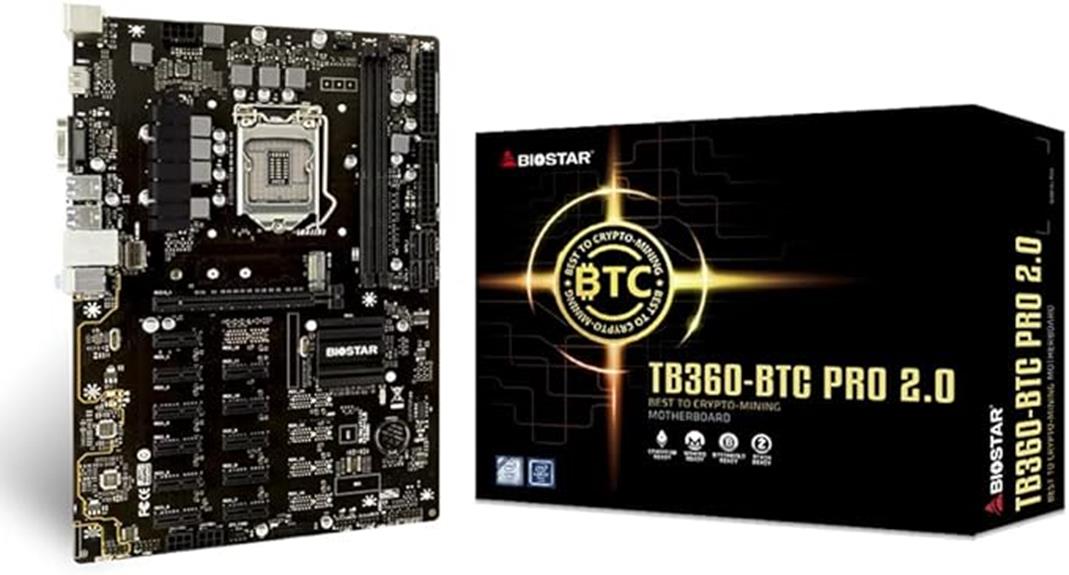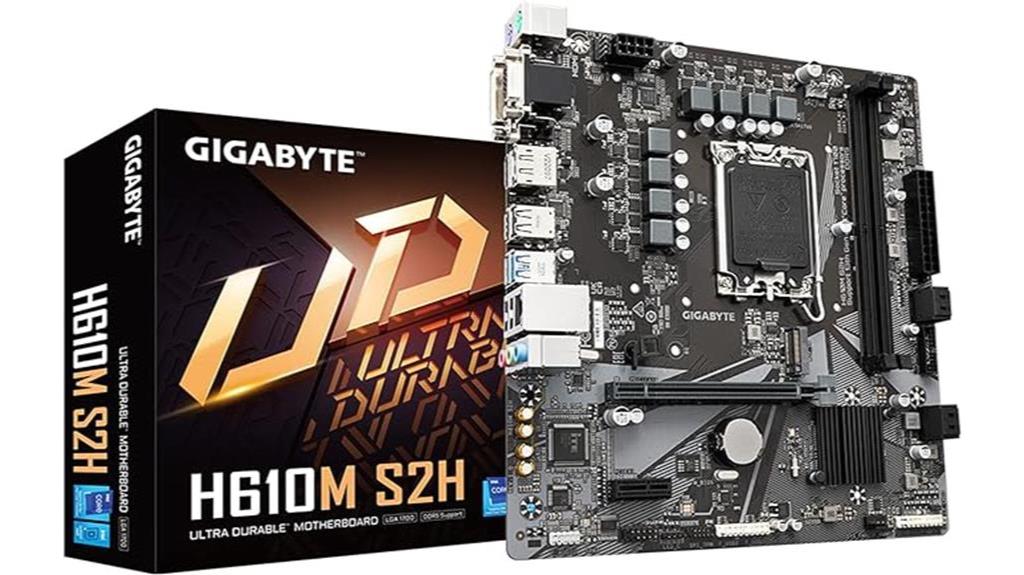When it comes to video editing, having the right motherboard can make a significant difference in your overall performance. Take, for example, the GIGABYTE Z590 Vision G Motherboard, which offers exceptional stability and power delivery for seamless editing sessions.
But this is just the tip of the iceberg. In this discussion, we will explore the three best motherboards for video editing, each tailored to enhance your editing experience and boost your productivity.
From advanced features to top-notch performance, these motherboards have it all. So, whether you’re a professional editor or an aspiring content creator, read on to discover the perfect motherboard that will take your editing skills to new heights.
Key Takeaways
- The GIGABYTE Z590 Vision G Motherboard supports 11th and 10th Gen Intel Core series processors and offers features like Dual Channel Non-ECC Unbuffered DDR4 memory and VisionLINK I/O design for optimal cable management.
- The TB360-BTC PRO 2.0 Mining Motherboard is suitable for mining purposes but some users have reported issues with using more than 7 GPUs and have experienced BIOS updates and driver issues.
- The GIGABYTE H610M S2H Motherboard supports 13th/12th Gen Intel Core Series Processors and offers features like Dual Channel Non-ECC Unbuffered DDR5 memory, PCI 4.0 and a single NVMe PCIe 3.0 x4 M.2 slot for high-speed data transfer and storage capabilities. However, it lacks Wi-Fi connectivity.
- When choosing motherboards for video editing, factors to consider include performance requirements, connectivity options, expansion capabilities, compatibility with video editing software, and price considerations.
GIGABYTE Z590 Vision G Motherboard

The GIGABYTE Z590 Vision G Motherboard is an excellent choice for video editors in need of powerful performance and comprehensive connectivity. With support for 11th and 10th Gen Intel Core series processors, this motherboard delivers exceptional processing power. It also features Dual Channel Non-ECC Unbuffered DDR4 memory, allowing for efficient multitasking and smooth editing workflows.
The VisionLINK I/O design ensures optimal cable management, keeping your workspace clean and organized. Additionally, the Intel 2.5GbE LAN provides high-bandwidth and low-latency network support, ideal for collaborative editing projects. The motherboard boasts front and rear USB3.2 Gen 2×2 Type-C connectors, offering a wide range of connectivity options.
With PCIe 4.0 hardware design and a maximum memory capacity of up to 128GB, the Z590 Vision G provides the performance and capacity required for demanding video editing tasks. Its effective cooling solution design and Smart Fan 6 features further enhance thermal dissipation, ensuring stable performance even during intensive editing sessions.
Overall, the GIGABYTE Z590 Vision G Motherboard provides the power, connectivity, and reliability that video editors need to excel in their work.
Best For: Video editors in need of powerful performance and comprehensive connectivity.
Pros:
- Powerful performance support for 11th and 10th Gen Intel Core series processors.
- Comprehensive connectivity with front and rear USB3.2 Gen 2×2 Type-C connectors.
- Effective cooling solution design for better thermal dissipation.
Cons:
- Some users experienced issues with M.2 slots and PCIe lanes.
TB360-BTC PRO 2.0 Mining Motherboard (Upgraded Model)

For video editors who require a high-performance motherboard, the TB360-BTC PRO 2.0 Mining Motherboard (Upgraded Model) offers exceptional features and compatibility.
This motherboard supports 9th and 8th Generation Intel Core Processors and features an Intel B360 single chip architecture. It also supports M.2 SATA III (6Gb/s) Connector and 2-DIMM DDR4-1866/2133/2400/2666 up to 32G maximum capacity.
With its 12 PCIe 3.0 slots, this motherboard provides ample room for expansion. However, some users have reported issues with using more than 7 GPUs and experienced crashes and video problems. BIOS updates and driver issues have also been mentioned.
On the positive side, some users have found this motherboard to work perfectly for mining rigs, with fast response and mining machines starting mining under 60 seconds. It’s recommended for mining, but caution is advised when choosing risers and avoiding Windows OS.
Best For: Video editors and miners looking for a high-performance motherboard with support for multiple GPUs.
Pros:
- Supports 9th and 8th Generation Intel Core Processors
- 12 PCIe 3.0 slots for ample expansion
- Fast response and quick mining startup
Cons:
- Some users experienced issues with using more than 7 GPUs
GIGABYTE H610M S2H Motherboard (H610/ Intel/LGA 1700/ Micro ATX/ DDR5/ Single M.2/ PCIe 4.0/ USB 3.2 Gen1/ Realtek GbE LAN)

With its upgraded power design, high-grade storage standards, and outstanding connectivity, the GIGABYTE H610M S2H Motherboard (H610/ Intel/LGA 1700/ Micro ATX/ DDR5/ Single M.2/ PCIe 4.0/ USB 3.2 Gen1/ Realtek GbE LAN) stands out as the ideal choice for video editing enthusiasts.
This motherboard supports 13th/12th Gen Intel Core Series Processors and features a 6+1+1 Hybrid Digital VRM Design for efficient power delivery. It also supports Dual Channel Non-ECC Unbuffered DDR5 memory, providing faster and more reliable performance.
The inclusion of PCI 4.0 and a single NVMe PCIe 3.0 x4 M.2 slot ensures high-speed data transfer and storage capabilities. With USB 3.2 Gen1 ports, you can connect your external devices with ease. The Realtek GbE LAN ensures stable and reliable network connectivity.
Overall, the GIGABYTE H610M S2H Motherboard offers the necessary features and performance to enhance your video editing experience.
Best For: Video editing enthusiasts looking for a high-performance motherboard with upgraded power design and fast data transfer capabilities.
Pros:
- Supports 13th/12th Gen Intel Core Series Processors
- Dual Channel Non-ECC Unbuffered DDR5 memory for faster and more reliable performance
- PCI 4.0 and a single NVMe PCIe 3.0 x4 M.2 slot for high-speed data transfer and storage capabilities
Cons:
- Lack of Wi-Fi
Factors to Consider When Choosing Motherboards for Video Editing
When choosing a motherboard for video editing, there are several factors to consider.
First and foremost, you need to assess the performance requirements of your video editing software and ensure that the motherboard can handle the processing power and memory capacity needed.
Additionally, connectivity options such as USB ports, Thunderbolt support, and Ethernet ports are crucial for transferring large video files quickly.
Expansion capabilities for adding more storage or graphics cards should also be taken into account.
Lastly, compatibility with your chosen video editing software is essential to ensure smooth operation.
Of course, price considerations are always a factor, so finding a motherboard that offers the right balance of features and affordability is key.
Performance Requirements
To ensure efficient video editing performance, it’s crucial to consider the necessary processing power when selecting a motherboard. Look for a motherboard that can handle the demands of video editing tasks.
It should support high-speed RAM and have multiple RAM slots, allowing for better performance when working with large video files. Additionally, ensure that the motherboard has ample slots for high-speed storage devices such as NVMe SSDs. This will help in quickly accessing and storing video files.
Compatibility with the latest CPU models is also important to ensure future-proofing for upgrades. Lastly, look for a motherboard with sufficient PCIe lanes for adding dedicated video editing GPUs, which can significantly boost rendering and editing speeds.
Connectivity Options
For optimal connectivity when choosing motherboards for video editing, it’s important to consider various factors.
Availability of high-speed USB3.2 Gen 2×2 Type-C connectors and PCIe 4.0 hardware design are key considerations.
Having front and rear USB3.2 Gen 2×2 Type-C connectors allows for faster data transfer, which is crucial when working with large video files.
Additionally, motherboards with PCIe 4.0 hardware design provide high-speed connectivity for peripherals such as graphics cards and SSDs, enhancing overall editing performance.
Comprehensive connectivity options, such as multiple NVMe PCIe M.2 connectors, offer storage flexibility, allowing for efficient access to and transfer of video files.
High-bandwidth network support, like Intel 2.5GbE LAN, ensures fast and efficient data transfer over the network.
Lastly, effective cooling solutions and smart fan features help maintain optimal performance during heavy video editing tasks, preventing overheating and slowdowns.
Expansion Capabilities
Now let’s explore the expansion capabilities to consider when selecting motherboards for video editing.
- When it comes to expansion slots, it’s important to consider the number and type available. This allows you to add additional components like GPUs, RAID cards, or high-speed storage devices.
- Look for support for the latest PCIe standards to ensure compatibility with future expansion cards and devices.
- Additionally, check the maximum RAM capacity and the number of memory slots available on the motherboard for potential future expansion.
- Consider the availability of M.2 slots with support for high-speed NVMe SSDs to expand your storage capabilities.
- Finally, evaluate the inclusion of additional headers for USB, SATA, or other connectors to accommodate the expansion of peripherals and storage devices.
Compatibility With Software
When selecting motherboards for video editing, it’s crucial to consider the compatibility with the specific video editing software you plan to use. Ensure that the motherboard supports the operating system required for your video editing software.
It’s also important to look for any reported issues or conflicts between the motherboard and the video editing software. Consider the recommended hardware specifications for your video editing software and verify compatibility with the motherboard.
Additionally, check for any specific features or optimizations that the motherboard may offer for video editing software. Compatibility with software is essential to ensure smooth and efficient video editing performance.
Therefore, thoroughly researching and selecting a motherboard that’s compatible with your chosen software can greatly enhance your video editing experience.
Price Considerations
Considering the budget and overall value of a motherboard is crucial when it comes to price considerations for video editing. Start by comparing prices across various retailers to find the best deal for the desired features. Don’t forget to check for any available discounts, promotions, or bundled deals that could lower the overall cost.
It’s important to balance the motherboard price with other essential components in your video editing setup. Evaluate the long-term value of the motherboard in relation to its price, ensuring it meets your current and future editing needs. Look for cost-effective options that provide the necessary features without unnecessary additional expenses.
Frequently Asked Questions
Can I Use Any Motherboard for Video Editing, or Do I Need a Specific Model?
We need a specific motherboard for video editing to ensure optimal performance. Not all motherboards are designed with the necessary features and capabilities required for efficient video editing tasks.
What Are the Advantages of Using a Motherboard Specifically Designed for Video Editing?
Using a motherboard specifically designed for video editing provides advantages like enhanced performance, faster data transfer, and better compatibility with high-end components. It optimizes your editing experience and boosts productivity.
Are There Any Compatibility Issues to Consider When Choosing a Motherboard for Video Editing?
When choosing a motherboard for video editing, compatibility issues are crucial to consider. Ensuring that your motherboard supports the necessary components like processors, RAM, and graphics cards is essential for optimal editing performance.
Can I Upgrade My Current Motherboard to Improve Video Editing Performance, or Do I Need to Purchase a New One?
We can upgrade our current motherboard to improve video editing performance, but it may not be as effective as purchasing a new one. Upgrading can help, but investing in a motherboard specifically designed for video editing will give better results.
How Do I Know if a Motherboard Has Sufficient Ports and Slots for My Video Editing Needs?
We determine if a motherboard has enough ports and slots for video editing needs by checking the specifications. Look for the number of USB, PCI-E, and RAM slots to ensure compatibility and expandability.
Conclusion
In conclusion, choosing the right motherboard for video editing is crucial to boost your editing performance.
While the GIGABYTE Z590 Vision G, TB360-BTC PRO 2.0, and GIGABYTE H610M S2H are all excellent options, some may argue that they’re expensive.
However, investing in a high-quality motherboard will ultimately save you time and frustration in the long run, allowing you to focus on creating stunning videos without any technical limitations.
Don’t compromise on your editing experience, choose the best motherboard for your needs and unleash your creativity.

